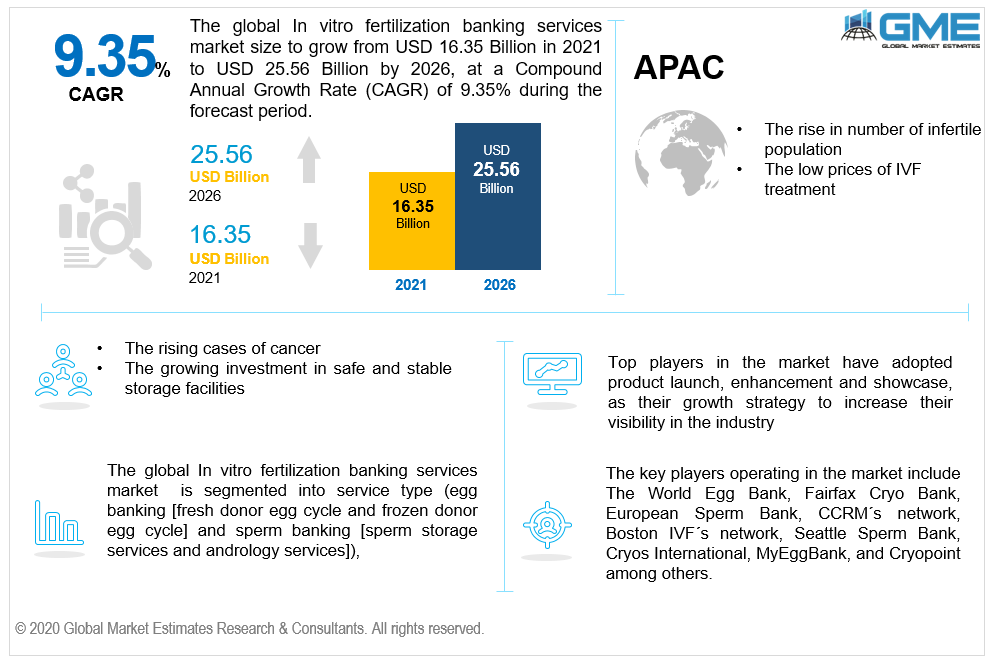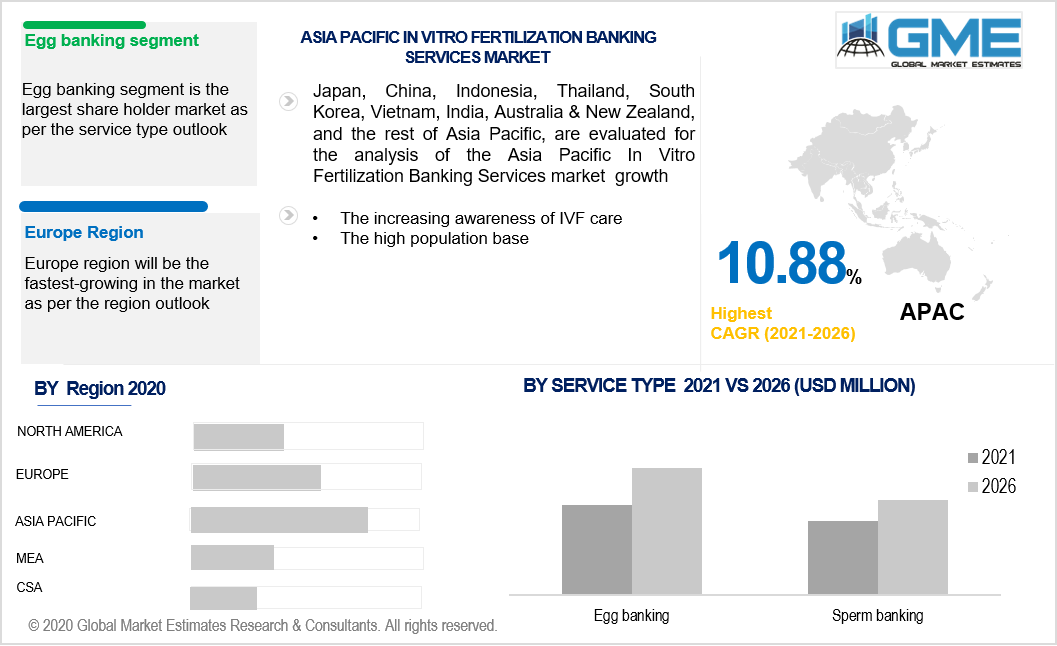
Global In Vitro Fertilization Banking Services Market Size, Trends & Analysis - Forecasts to 2026 By Service Type (Egg Banking [Fresh Donor Egg Cycle and Frozen Donor Egg Cycle] and Sperm Banking [Sperm Storage Services and Andrology Services]), By Region (North America, Europe, Asia Pacific, Middle East & Africa, and Central and South America) End-User Landscape, Company Market Share Analysis & Competitor Analysis
The rising cancer cases have resulted in the incidence of infertility among women and men which has become the prominent factor in vitro fertilization banking services market growth. The global market will register a CAGR of 9.3% between (2021-2026). The increasing cases of infertility worldwide, the IVF, and ICSI treatments are increased due to job strain, stress, food preferences, and shifting lifestyles.
IVF is an assisted reproductive (ART) technology that involves extracting eggs from the ovaries of a woman and in vitro fertilizing them with sperm. The procedure includes inducing the ovulation of a woman, extracting an ovum from the ovaries of the woman, and enabling them to be fertilized by sperm in a laboratory.
IVF is one of the most frequently used therapies to support couples with infertility problems, which is a key factor behind the global growth of the demand for IVF services. The adoption of in vitro fertilization by couples facing fertility problems are increasing globally. The improvement in healthcare and life science applications also drives the demand for embryo banking, and andrology services, among others. As more individuals become aware of the process of in vitro fertilization, the willingness towards it has increased, fuelling embryo cryopreservation need.
A worldwide increase in disposable income, changes in food consumption increase which results in a rising preference for IVF in families. This is also supported by the increasing success rate of in vitro fertilization, which is 25-30 % according to 2018 figures.
The rise in fertility tourism, which is a practice of traveling for fertility treatment to another country or jurisdiction also referred to as reproduction tourism. The favourable government policies for treatments are also boosting the market growth. According to the data published by CDC, approximately 10% of women in the United States aged (15 to 44 years) are facing infertility problems. Approximately 4.5-6% of men in North America are facing infertile problems.
The developing countries are expected to focus on the low cost of IVF services with the increasing number of fertility clinics because of increasing awareness as well as a high population base. And, the growing investment in safe and stable egg/sperm storage facilities worldwide will provide the opportunity for the market to propel.

In vitro fertilization, the service type segment is dominated by the egg banking segment. The storing of eggs helps in extending the fertility of women as the success rate of this storing process is approximately 55 percent. Women who go through harsh treatments that harm fertility such as chemotherapy have a chance to get pregnant in the future due to egg banking services. It helps women to enter the workforce and develop a career with less risk of losing out on genetic motherhood by moving or rescheduling genetic motherhood to a later period.
The fresh egg is considered to be more preferable than the frozen egg due to the success rate associate with it. The fresh egg has a success rate of 25 percent better than frozen ones. But according to reports the chances of success depend on many factors such as the health of the patient, type of responders, and preference of the patient.
The increased male infertility issues are expected to further boost demand for sperm bank services due to abnormal and insufficient sperm volume and ejaculatory problems. Male infertility accounts for 30 percent of infertility cases, which is about one-fifth of all infertility cases, according to the American Association of Pregnancy. The increase in funding and government support programs across different countries is expected to improve the adoption of sperm banking services.

Asia Pacific region is expected to be the dominating region and expected to register peak growth rate between 2021-2026. A high population base in the region is one of the prominent reasons for this domination along with increased awareness of IVF care, low IVF treatment prices, a rise in the number of infertile populations, and an increase in disposable income among others.
The cases of polycystic ovarian syndrome (PCOS) are increasing in the region which causes the concern of infertility in women. According to the article published by Metropolis Healthcare, about 20 percent of Indian society suffers from similar PCOS reports across the country, showing how cases are rising. This concern is leading to the adoption of IVF in the Asia Pacific region.
The European region is going to see a rapid increase in the market due to the growing need for vitro fertilization banking services. According to recent study of European Policy Audit on Fertility, about 25 million people are facing conceiving difficulties in the region. The rate of infertility cases reported in Europe annually is rising by 9 percent, which is a concerning problem for the region and because of this, the demand for IVF is rising.
The World Egg Bank, Cryopoint, Fairfax Cryo Bank, MyEggBank, European Sperm Bank, CCRM´s network, Cryos International, Boston IVF´s network, and Seattle Sperm Bank are the key players involved in providing in vitro fertilization banking services
Please note: This is not an exhaustive list of companies profiled in the report.
In January 2017, Merck and Genea signed a contract to build a 'Centre of Excellence' (CoE). The goal of the CoE is to provide fertility practitioners with a strong understanding of the principles, procedures, and strategies that are carried out in high-quality clinics to help resolve the unmet needs of assisted reproductive care (ART).
In August 2020, Boston IVF’s network inaugurated their new fertility centre in Chestnut Hill, to offer their services to the maximum population.
We value your investment and offer free customization with every report to fulfil your exact research needs.
The Global In Vitro Fertilization Banking Services Market has been studied from the year 2019 till 2026. However, the CAGR provided in the report is from the year 2021 to 2026. The research methodology involved three stages: Desk research, Primary research, and Analysis & Output from the entire research process.

The desk research involved a robust background study which meant referring to paid and unpaid databases to understand the market dynamics; mapping contracts from press releases; identifying the key players in the market, studying their product portfolio, competition level, annual reports/SEC filings & investor presentations; and learning the demand and supply-side analysis for the In Vitro Fertilization Banking Services Market.

The primary research activity included telephonic conversations with more than 50 tier 1 industry consultants, distributors, and end-use product manufacturers.

Finally, based on the above thorough research process, an in-depth analysis was carried out considering the following aspects: market attractiveness, current & future market trends, market share analysis, SWOT analysis of the company and customer analytics.

Tailor made solutions just for you
80% of our clients seek made-to-order reports. How do you want us to tailor yours?
OUR CLIENTS